Fig. 1.

Genetic pathways controlling heading date in rice. Schematic representation of genetic pathways controlling flowering in rice. A circadian clock is shown at the top. Key heading date genes are indicated in oval backgrounds. Arrows indicate upregulation, and bars indicate downregulation. Rice has two florigen genes, Hd3a and RFT1, short day (SD) conditions accelerate heading by promoting the expression of Hd3a through Hd1 and Ehd1. Expression of Ehd1 can be upregulated or downregulated by many genes. Hd1 can be activated by OsGI under SD conditions. In long day (LD) conditions, Hd1 function reverses to flowering inhibition; this reversal is controlled by many other factors such as Ghd7 and DTH8 and is mediated by protein–protein interactions. The florigen proteins Hd3a and RFT1 are transported to the shoot apical meristem (SAM) after induction in the leaves. In the SAM, they form the florigen activation complex (FAC), and activate the expression of downstream targets, including members of MADS‐box transcription factor family genes that control phase transition of the SAM from vegetative to reproductive development. FAC and repressive FAC‐like complexes can also be formed in the SAM and leaves to fine tune the heading date.
